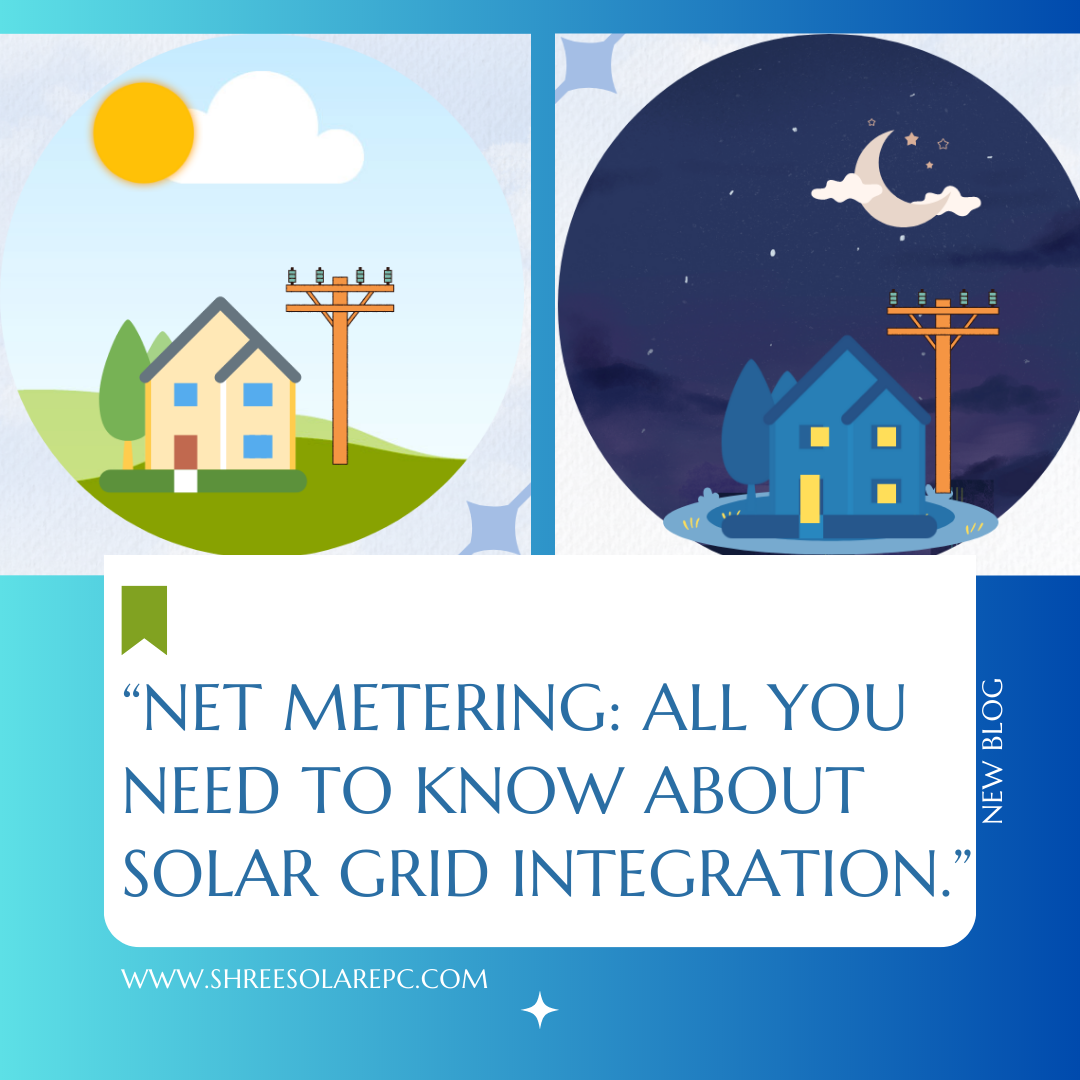
“Net Metering: All You Need To Know About Solar Grid Integration”
Published on 20th August, 2023.
As the world shifts towards cleaner and more sustainable energy sources, solar power has emerged as a prominent player in the renewable energy landscape. Picture this: your rooftop adorned with sleek solar panels harnessing the sun’s boundless energy, while your home hums with power, illuminated by the very essence of daylight and at the same time reducing your carbon footprint. But there’s more to this solar-powered symphony than meets the eye. It’s a dance between innovation and tradition, a feat of technology and policy seamlessly intertwined. One of the key aspects that has facilitated the widespread adoption of solar energy is net metering. Net metering is a crucial policy that allows solar panel owners to not only generate their own electricity but also give excess energy back to the grid. In this blog post, we’ll delve into the intricacies of net metering and explore how solar grid integration works.
What is Net Metering?
Net metering is a billing arrangement that enables solar panel owners to earn credits for the excess electricity they produce. When your solar panels generate more electricity than you consume, the surplus energy is sent back to the grid.
In return, your utility company provides you with credits that can be used when your solar panels are not producing enough energy, such as during nighttime or cloudy days. Essentially, net metering allows you to offset your energy consumption with the energy you’ve contributed to the grid.
It allows individuals and businesses to benefit from their own renewable energy generation while remaining connected to the grid for times when their solar production falls short of their energy needs. This arrangement promotes the adoption of clean energy and contributes to a more sustainable energy mix. It’s important to note that net metering policies can vary by location and can be subject to changes based on regulatory decisions and shifts in energy policy.

"Net metering is a billing arrangement that enables solar panel owners to earn credits for the excess electricity they produce. When your solar panels generate more electricity than you consume, the surplus energy is sent back to the grid. "

How Does Solar Grid Integration Work?
Solar Panels and Energy Generation: Solar panels consist of photovoltaic cells that convert sunlight into direct current (DC) electricity. This electricity is then sent to an inverter, which converts DC electricity into alternating current (AC) electricity, the type of electricity used in homes and businesses.
Energy Consumption and Excess Generation: The electricity generated by your solar panels is first used to power your home’s electrical needs. If your solar panels produce more electricity than you need at that moment, the excess energy flows back to the grid.
Bidirectional Metering: To accurately measure the energy flow between your solar panels and the grid, a bidirectional meter is installed. This meter records both the energy you consume from the grid and the energy you feed back into the grid.
Credit Accumulation: When your solar panels generate more electricity than you consume and the excess electricity is sent back to the grid, you are credited for that surplus energy.
Credit Usage: During periods when your solar panels aren’t generating enough electricity to meet your needs (such as at night or during cloudy days), you can draw energy from the grid. The credits you earned through net metering are then applied to offset the cost of this electricity, effectively reducing your electricity bill.
Billing and Settlement: At the end of a billing period (usually monthly), your utility company calculates the net difference between the electricity you’ve consumed from the grid and the excess electricity you’ve contributed. If you’ve generated more electricity than you’ve used, you’ll receive a credit that can be carried forward to future billing periods or potentially even compensated for in some cases.
Grid Contribution: The excess electricity generated by solar panel systems is fed into the grid, contributing to the overall energy supply of the local area. This can help offset the demand for energy from conventional power sources during periods of peak demand. During periods when your solar panels are not generating enough electricity, such as at night or on cloudy days, you can draw energy from the grid. The credits you earned through net metering are then applied to offset the cost of this energy.
Challenges and Considerations
While net metering offers various benefits, it’s important to consider some challenges:
Policy Changes: Net metering policies can vary by location and may change over time, affecting the financial viability of solar investments. The policies may differ in terms of the cap on system size eligible for net metering, compensation rates for excess generation, and administrative procedures.
System Sizing: Properly sizing your solar panel system is essential to ensure that you generate enough energy to meet your needs while still being able to benefit from excess generation.
A Call for Cohesion
Net metering has the potential to revolutionize energy dynamics by turning consumers into prosumers, contributing to a cleaner and more resilient energy grid. However, the major challenge of regulatory uncertainty within the net metering policy must be acknowledged and resolved for this potential to be fully realized in India. By unifying policies and providing a clear roadmap for solar grid integration, India can harness its abundant solar resources and illuminate a brighter energy future for generations to come.